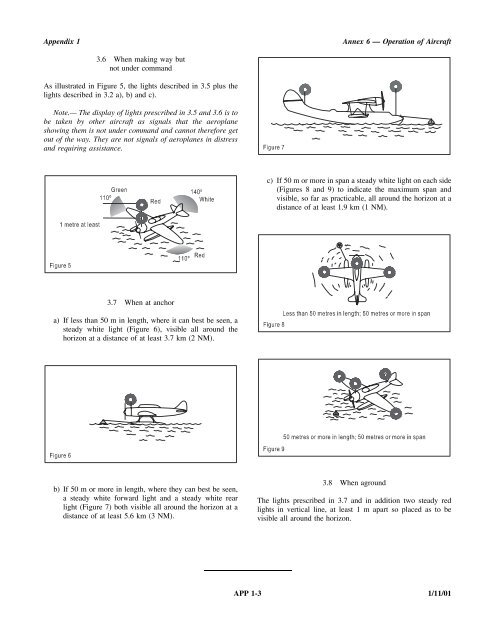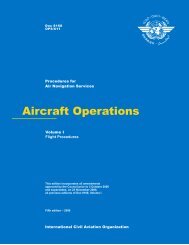Operation of Aircraft
Annex 6, Part I
Annex 6, Part I
- No tags were found...
Create successful ePaper yourself
Turn your PDF publications into a flip-book with our unique Google optimized e-Paper software.
Appendix 1<br />
Annex 6 — <strong>Operation</strong> <strong>of</strong> <strong>Aircraft</strong><br />
3.6 When making way but<br />
not under command<br />
As illustrated in Figure 5, the lights described in 3.5 plus the<br />
lights described in 3.2 a), b) and c).<br />
Note.— The display <strong>of</strong> lights prescribed in 3.5 and 3.6 is to<br />
be taken by other aircraft as signals that the aeroplane<br />
showing them is not under command and cannot therefore get<br />
out <strong>of</strong> the way. They are not signals <strong>of</strong> aeroplanes in distress<br />
and requiring assistance.<br />
c) If 50 m or more in span a steady white light on each side<br />
(Figures 8 and 9) to indicate the maximum span and<br />
visible, so far as practicable, all around the horizon at a<br />
distance <strong>of</strong> at least 1.9 km (1 NM).<br />
3.7 When at anchor<br />
a) If less than 50 m in length, where it can best be seen, a<br />
steady white light (Figure 6), visible all around the<br />
horizon at a distance <strong>of</strong> at least 3.7 km (2 NM).<br />
b) If 50 m or more in length, where they can best be seen,<br />
a steady white forward light and a steady white rear<br />
light (Figure 7) both visible all around the horizon at a<br />
distance <strong>of</strong> at least 5.6 km (3 NM).<br />
3.8 When aground<br />
The lights prescribed in 3.7 and in addition two steady red<br />
lights in vertical line, at least 1 m apart so placed as to be<br />
visible all around the horizon.<br />
APP 1-3 1/11/01












